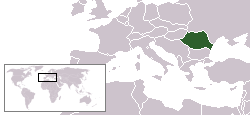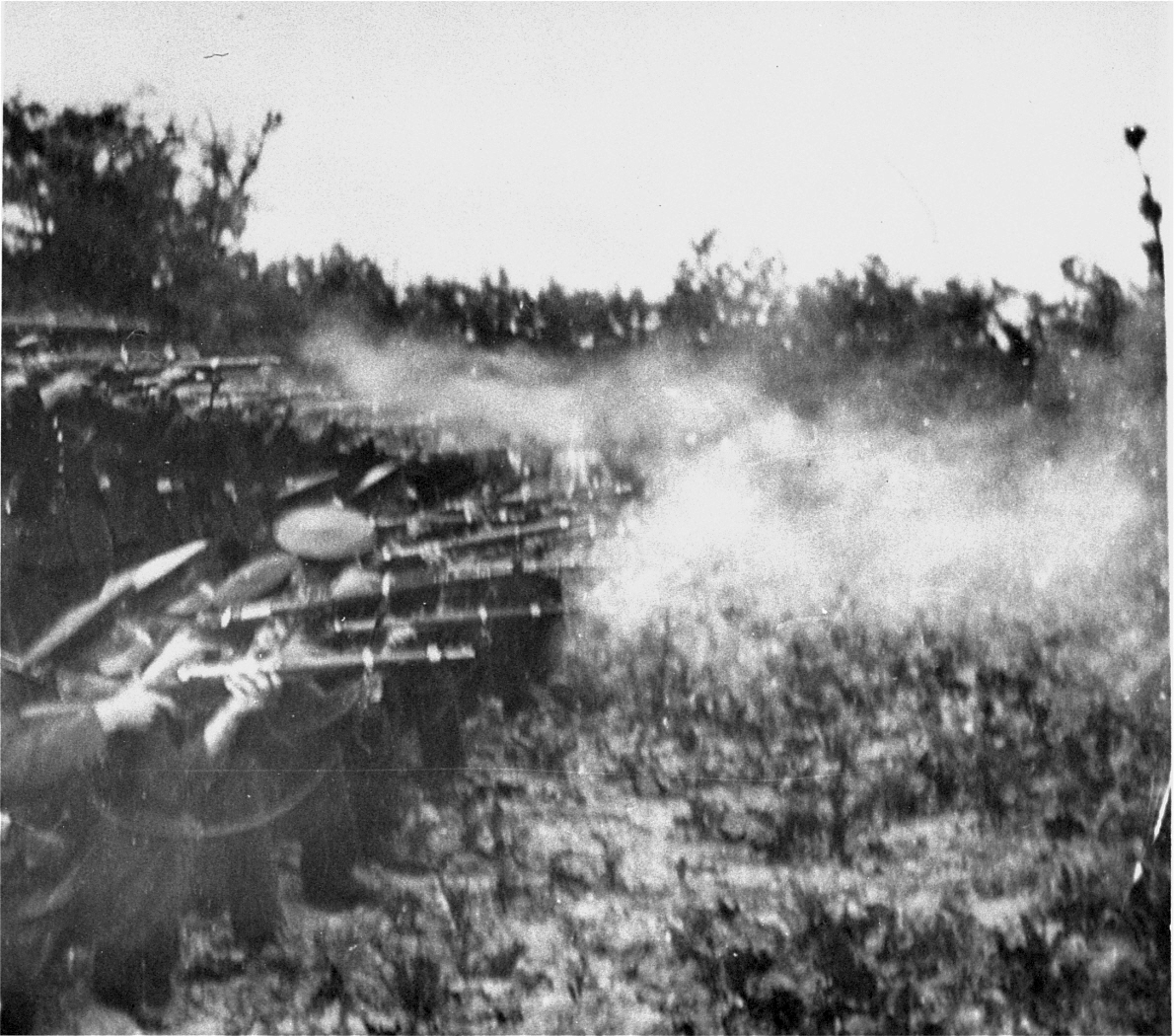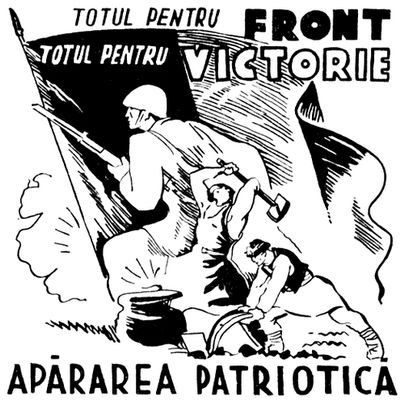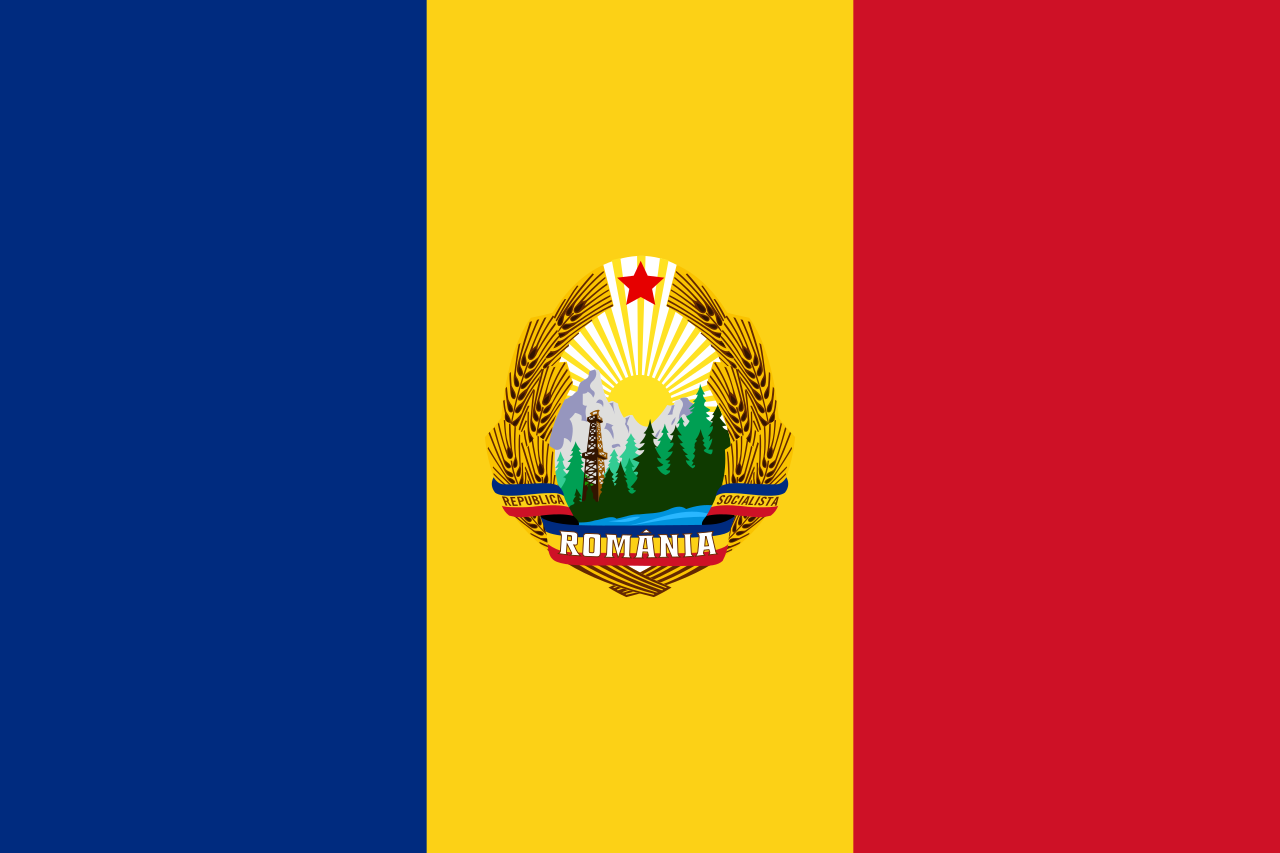Socialist Republic of Romania (1947–1989): Difference between revisions
More languages
More actions
m (Rewrote for ease of reading) Tag: Visual edit |
TheKanzler (talk | contribs) m (Minor clean-up; added "names" section) Tag: Visual edit |
||
| Line 1: | Line 1: | ||
{{Infobox country|name=Romanian People's Republic<br />{{small|(1947–1965)}}<br />{{small|Republica Populară Romînă|paren=omit}}<hr>Socialist Republic of Romania<br />{{small|(1965–1989)}}<br />{{small|Republica Socialistă România|paren=omit}}|image_flag=Flag of Romania (1965–1989).png|life_span=1947 | {{Infobox country|name=Romanian People's Republic<br />{{small|(1947–1965)}}<br />{{small|Republica Populară Romînă|paren=omit}}<hr>Socialist Republic of Romania<br />{{small|(1965–1989)}}<br />{{small|Republica Socialistă România|paren=omit}}|image_flag=Flag of Romania (1965–1989).png|life_span=1947–1989|motto=''Proletari din toate țările, uniți-vă!''|englishmotto=("Proletarians of all countries, unite!")|national_anthem=''Zdrobite Cătușe'' (1948–1953)<br />''Te slăvim, Românie'' (1953–1977)<br />''Trei Culori'' (1977–1989)|image_map=Map of the Socialist Republic of Romania.png|image_coat=Coat of arms of SR Romania.png|capital=Bucharest|official_languages=Romanian|mode_of_production=[[Socialism]]|government_type=Unitary [[Marxism-Leninism|Marxist-Leninist]] [[socialist republic]]|title_leader=General Secretary|year_leader1=1944-1954|leader1=[[Gheorghe Gheorghiu-Dej]]|year_leader2=1954-1955|leader2=[[Gheorghe Apostol]]|year_leader3=1955-1965|leader3=Gheorghe Gheorghiu-Dej|year_leader4=1965-1989|leader4=[[Nicolae Ceaușescu]]|title_representative=Head of State|year_representative1=1947-1952 (first)|representative1=[[Constantin Ion Parhon]]|year_representative2=1967-1989 (last)|representative2=Nicolae Ceaușescu|title_deputy=President of the Council of Ministers|year_deputy1=1947-1952 (first)|deputy1=[[Petru Groza]]|year_deputy2=1982-1989 (last)|deputy2=[[Constantin Dăscălescu]]|legislature=[[Grand National Assembly (Romania)|Grand National Assembly]] (Marea Adunare Națională)|established_event1=Proclamation of the Republic|era=[[Cold War]]|established_date1=30 December 1947|established_event2=First Constitution|established_date2=13 April 1948|established_event3=Second Constitution|established_date3=24 September 1952|established_event4=Third Constitution|established_date4=21 August 1965|established_event5=''De facto'' disestablished|established_date5=27 December 1989|established_event6=''De jure'' disestablished|established_date6=8 December 1991|area_km2=238,397|population_estimate=23,151,564|population_estimate_year=1989|population_density_km2=97.11 per|HDI_year=1989|HDI=0.863|currency=Romanian Leu|calling_code=40|today=[[Romania]]}} | ||
The '''Socialist Republic of Romania''' (Romanian: Republica Socialistă România, '''RSR''') was a [[socialist state]] that existed from 1947 to 1989 | The '''Socialist Republic of Romania''' (Romanian: ''Republica Socialistă România'', '''RSR''') was a [[socialist state]] that existed from December 1947 to December 1989. The [[Marxist-Leninist]] government ruled until 1989, when the Romanian leader [[Nicolae Ceaușescu]] was overthrown and the government replaced with one aligned with [[North Atlantic Treaty Organization|Western capitalist]] interests. | ||
== Names == | |||
* '''Romanian People's Republic''' (''Republica Populară Română'', '''RPR''') (1947–1953; 1964–1965) | |||
* '''Romanian People's Republic''' (''Republica Populară Romînă'', '''RPR''') (1953–1964) | |||
* '''Socialist Republic of Romania''' (''Republica Socialistă România'', '''RSR''') (1965–1989) | |||
== History == | == History == | ||
| Line 10: | Line 16: | ||
The coup was carried out on 23 August 1944, following the plan proposed by the PCR. After an hour-long discussion with the King, Antonescu refused to sign the armistice, and was arrested by a colonel and four soldiers. Antonescu was executed two years later, on 1 June 1946. | The coup was carried out on 23 August 1944, following the plan proposed by the PCR. After an hour-long discussion with the King, Antonescu refused to sign the armistice, and was arrested by a colonel and four soldiers. Antonescu was executed two years later, on 1 June 1946. | ||
On the day of Antonescu's arrest, the Romanian army switched sides and began fighting against the [[German Reich (1933–1945)|Nazis]] along with the [[Union of Soviet Socialist Republics (1922–1991)|Soviet Union]].<ref name=":0">{{Web citation|author=Patricia Gorky|newspaper=[[Liberation News]]|title=Romania: 30 years removed from socialism|date=2019-12-26|url=https://www.liberationnews.org/romania-30-years/|archive-url=https://web.archive.org/web/20220319072442/https://www.liberationnews.org/romania-30-years/|archive-date=2022-03-19|retrieved=2022-10-08}}</ref> Following this, a government formed by the National Democratic Front (FND; consisting of the [[Romanian Communist Party|Communist Party]], as well as the [[National Liberal Party (Romania, 1875)|National Liberal Party]] (PNL), the [[National Peasants' Party]] (PNȚ) and the [[Romanian Social Democratic Party|Social Democratic Party]] (PSD)) would take power.<ref>{{Citation|author=Silviu Brucan|year=1993|title=The Wasted Generation: Memoirs of the Romanian Journey from Capitalism to Socialism and Back|page=20-21|publisher=Westview Press}}</ref> | |||
=== Socialist rule === | === Socialist rule === | ||
In 1946, Romania held its largest election ever and nearly 7 million people voted for the Communist-led National Democratic Front. The new government forced King Michael to abdicate. In | |||
==== Gheorghe Gheorghiu-Dej ==== | |||
In 1946, Romania held its largest election ever and nearly 7 million people voted for the Communist-led Bloc of Democratic Parties (BPD), formerly the National Democratic Front. The new government forced King Michael to abdicate. In 1948, the PCR and PSD merged to form the Romanian Workers' Party (PMR), led by Gheorghe Gheorghiu-Dej. The country began an electrification plan and confiscated farmland, mansions, and castles from the [[nobility]]. Under socialism, industrial output increased by more than seven times and the life expectancy rose by 30 years. By 1980, the socialist government had built 4.6 million houses. | |||
Romania joined the [[Warsaw Pact]] in 1955. With [[People's Republic of China|Chinese]] support, it negotiated the removal of Soviet soldiers from Romania and was neutral during the [[Sino-Soviet Split]]. | Romania joined the [[Warsaw Pact]] in 1955. With [[People's Republic of China|Chinese]] support, it negotiated the removal of Soviet soldiers from Romania and was neutral during the [[Sino-Soviet Split]]. | ||
==== Nicolae Ceaușescu ==== | |||
Gheorghiu-Dej died in 1965 and Nicolae Ceaușescu succeeded him as General Secretary. Ceaușescu ran the country on a platform of Romanian [[nationalism]], wanting to make Romania a world power, and sought out Western financial aid from institutions such as the [[International Monetary Fund|IMF]] and [[The World Bank|World Bank]]. In the 1980s, Romania had to ration electricity and food due to IMF austerity measures.<ref name=":0" />[[File:Illustration issued by the PCR, calling the population to arms.jpg|thumb|"Everything for the front, everything for victory - The Patriotic Defence" An illustration issued by the PCR, calling the population to arms.]] | Gheorghiu-Dej died in 1965 and Nicolae Ceaușescu succeeded him as General Secretary. Ceaușescu ran the country on a platform of Romanian [[nationalism]], wanting to make Romania a world power, and sought out Western financial aid from institutions such as the [[International Monetary Fund|IMF]] and [[The World Bank|World Bank]]. In the 1980s, Romania had to ration electricity and food due to IMF austerity measures.<ref name=":0" />[[File:Illustration issued by the PCR, calling the population to arms.jpg|thumb|"Everything for the front, everything for victory - The Patriotic Defence" An illustration issued by the PCR, calling the population to arms.]] | ||
=== | === Counter-revolution === | ||
In April 1989, Romania finished paying its debt to the IMF and banned taking any further loans from the West. On 21 December 1989, Ceaușescu announced he would raise wages and pensions.<ref name=":0" /> | In April 1989, Romania finished paying its debt to the IMF and banned taking any further loans from the West. On 21 December 1989, Ceaușescu announced he would raise wages and pensions.<ref name=":0" /> | ||
Revision as of 07:56, 30 September 2023
| Romanian People's Republic (1947–1965) Republica Populară Romînă Socialist Republic of Romania (1965–1989) Republica Socialistă România | |
|---|---|
| 1947–1989 | |
Motto: Proletari din toate țările, uniți-vă! ("Proletarians of all countries, unite!") | |
Anthem: Zdrobite Cătușe (1948–1953) Te slăvim, Românie (1953–1977) Trei Culori (1977–1989) | |
 | |
| Capital | Bucharest |
| Official languages | Romanian |
| Dominant mode of production | Socialism |
| Government | Unitary Marxist-Leninist socialist republic |
| General Secretary | |
• 1944-1954 | Gheorghe Gheorghiu-Dej |
• 1954-1955 | Gheorghe Apostol |
• 1955-1965 | Gheorghe Gheorghiu-Dej |
• 1965-1989 | Nicolae Ceaușescu |
| Head of State | |
• 1947-1952 (first) | Constantin Ion Parhon |
• 1967-1989 (last) | Nicolae Ceaușescu |
| President of the Council of Ministers | |
• 1947-1952 (first) | Petru Groza |
• 1982-1989 (last) | Constantin Dăscălescu |
| Legislature | Grand National Assembly (Marea Adunare Națională) |
| History | |
• Proclamation of the Republic | 30 December 1947 |
• First Constitution | 13 April 1948 |
• Second Constitution | 24 September 1952 |
• Third Constitution | 21 August 1965 |
• De facto disestablished | 27 December 1989 |
• De jure disestablished | 8 December 1991 |
| Area | |
• Total | 238,397 km² |
| Population | |
• 1989 estimate | 23,151,564 |
• Density | 97.11 per km² |
| HDI (1989) | 0.863 |
| Currency | Romanian Leu |
| Calling code | 40 |
| Today part of | Romania |
The Socialist Republic of Romania (Romanian: Republica Socialistă România, RSR) was a socialist state that existed from December 1947 to December 1989. The Marxist-Leninist government ruled until 1989, when the Romanian leader Nicolae Ceaușescu was overthrown and the government replaced with one aligned with Western capitalist interests.
Names
- Romanian People's Republic (Republica Populară Română, RPR) (1947–1953; 1964–1965)
- Romanian People's Republic (Republica Populară Romînă, RPR) (1953–1964)
- Socialist Republic of Romania (Republica Socialistă România, RSR) (1965–1989)
History
August 1944 coup d'état
On the night of the 13–14 June 1944, representatives of the Romanian Communist Party (PCR) presented their plan for the removal of fascist leader Ion Antonescu from power to the representatives of the King.
The proposed plan would have King Michael order Antonescu to sign an armistice with the Allies and, if he refused, have him arrested on the spot.

The coup was carried out on 23 August 1944, following the plan proposed by the PCR. After an hour-long discussion with the King, Antonescu refused to sign the armistice, and was arrested by a colonel and four soldiers. Antonescu was executed two years later, on 1 June 1946.
On the day of Antonescu's arrest, the Romanian army switched sides and began fighting against the Nazis along with the Soviet Union.[1] Following this, a government formed by the National Democratic Front (FND; consisting of the Communist Party, as well as the National Liberal Party (PNL), the National Peasants' Party (PNȚ) and the Social Democratic Party (PSD)) would take power.[2]
Socialist rule
Gheorghe Gheorghiu-Dej
In 1946, Romania held its largest election ever and nearly 7 million people voted for the Communist-led Bloc of Democratic Parties (BPD), formerly the National Democratic Front. The new government forced King Michael to abdicate. In 1948, the PCR and PSD merged to form the Romanian Workers' Party (PMR), led by Gheorghe Gheorghiu-Dej. The country began an electrification plan and confiscated farmland, mansions, and castles from the nobility. Under socialism, industrial output increased by more than seven times and the life expectancy rose by 30 years. By 1980, the socialist government had built 4.6 million houses.
Romania joined the Warsaw Pact in 1955. With Chinese support, it negotiated the removal of Soviet soldiers from Romania and was neutral during the Sino-Soviet Split.
Nicolae Ceaușescu
Gheorghiu-Dej died in 1965 and Nicolae Ceaușescu succeeded him as General Secretary. Ceaușescu ran the country on a platform of Romanian nationalism, wanting to make Romania a world power, and sought out Western financial aid from institutions such as the IMF and World Bank. In the 1980s, Romania had to ration electricity and food due to IMF austerity measures.[1]

Counter-revolution
In April 1989, Romania finished paying its debt to the IMF and banned taking any further loans from the West. On 21 December 1989, Ceaușescu announced he would raise wages and pensions.[1]
In December 1989, protestors attacked police and began a brief civil war that overthrew the socialist government of Romania. Hundreds of police and soldiers were killed as well as 142 protestors. The CIA-backed Western media claimed that Romania killed over 60,000 peaceful protestors.[3]
References
- ↑ 1.0 1.1 1.2 Patricia Gorky (2019-12-26). "Romania: 30 years removed from socialism" Liberation News. Archived from the original on 2022-03-19. Retrieved 2022-10-08.
- ↑ Silviu Brucan (1993). The Wasted Generation: Memoirs of the Romanian Journey from Capitalism to Socialism and Back (pp. 20-21). Westview Press.
- ↑ Austin Murphy (2000). The Triumph of Evil: 'The Documented Facts about Eastern Europe and Communism: A Refutation of Popular Myths about the True Good Guys' (p. 74). [PDF] Fucecchio, Italy: European Press Academic Publishing. ISBN 8883980026


